By almost any measure, the Toyota Corolla is one of the most significant vehicles built over the past half century. That’s certainly true if you’re going by sales, the compact sedan lagging only the bigger Toyota Camry on the passenger car charts.
That said, the outgoing Corolla has taken its share of criticism, even from within Toyota where senior officials have been promising to move away from the bland styling of the outgoing model. They gave a hint of what they had in mind with the Furia Corolla concept unveiled at the Detroit Auto Show last winter. And while the production 2014 sedan has clearly been toned down, the new Corolla will likely disappoint few of its traditional fans.
The only ones who might take pause are those few looking for something smaller. If anything, the 2014 Toyota Corolla has grown both longer and a bit wider than its immediate predecessor. The wheelbase has been extended by 3.5 inches – and the payoff is obvious for both those sitting up front and in back since most of those extra inches have been translated into interior space.
The cabin of the 2014 Corolla has been elevated with new material and fresh design, which makes the plastic inside the car seem less, well, plastic looking, and both more vibrant and more comfortable. Toyota also has taken the extra step of expanding the interior color schemes to get away from the “you-can-get-any-color-you want-as-long-as-it’s-beige approach that has become the norm in the compact and subcompact segments.
The 2014 Corolla also offers plenty of visibility and the cabin is also relatively quiet, which helps mitigate some of the stress that comes with highway commuting.
The interior styling, with its attention to detail, larger display screen and more comfortably tailored seats, also serves as a complement to the new exterior styling, which gives the 2014 Corolla a more contemporary feel.
(Toyota considering a hatchback version of the new Corolla. Click Here for the full story.)
True, it’s not the striking breakthrough that the Furia concept was meant to suggest, but it definitely indicates the Toyota design department has listened to CEO Akio Toyoda’s command to put more “passion” in the maker’s new products.
And that’s for good reason considering Toyota has to move on from the Baby Boomers that have traditionally kept its showrooms busy and start appealing to the next generation of less loyal customers. Toyota planners knew they needed the new Corolla to look more aggressive and appealing to younger buyers, particularly young men.
The result is a design that looks fresh and up-to-date, perhaps even flashy enough to disorient Corolla’s older and more traditional buyers, who have always seemed comfortable with the compact model’s generic anonymity.
Passion is, of course, more than skin deep, and the other challenge for the Corolla development team was to find a way to upgrade the appliance-like ride and handling of the outgoing model without alienating traditional buyers.
A key step was adopting a new electric power steering system which actually makes a driver feel like they’re in touch with the road. It’s not quite the sporty feel some competing sedans – such as the Mazda6 – deliver, but it’s a major step forward, and the ride and handling is enhanced by a firmer suspension that no longer waddles through even the most benign corners.
Bottom line, it’s a significant improvement over the previous model which Toyota rolled out six years ago.
Toyota also has made some welcome improvements to the powertrain line-up, delivering both improved power and better mileage. Available on the L, LE, and S grades, the base 1.8-liter inline-four features variable valve timing and is 132 horsepower and an upgraded version of the engine bumps that to 140 hp.
We were a bit surprised to see Toyota continue to offer a 4-speed automatic, a transmission package that is rapidly vanishing even on base vehicles, but buyers can also get a 6-speed manual, or a new Continuously Variable Transmission. The sporty Corolla S offers a CVTi-S with seven sequential stepped shift points that can be actuated by steering wheel paddle shifters.
The LE Eco trim, meanwhile, adopts Toyota’s Valvematic system – a technology appearing in the U.S. for the first time – to further expand the benefits of continuously variable valve timing. It helps deliver an added 5% in fuel economy.
(Toyota counts on new Corolla to deliver big sales boost. Click Here for more.)
At the low end, the Corolla will deliver an EPA-estimated 27 mpg in the city and 36 on the highway, with the high-end nudging 30 and 42 – a new benchmark, Toyota claims, among gas-powered compacts with an automatic transmission.
Toyota’s “Star” safety system — with its multiple airbagas as well as a range of electronic safety features, such as antilock brakes and electronic stablity control — is standard on all versions of the 2014 Toyota Corolla.
Corolla pricing starts at $16,800 for the L grade with a new 6-speed manual transmission. The Corolla L with 4-speed automatic is priced at $17,400.and includes LED headlamps, Bluetooth connectivity, and whiplash-injury-lessening seats. The Corolla LE starts at $18,300, while the sporty S model nudges up to $21,300.
(Toyota planning to introduce sportier new hybrid concept at upcoming Frankfurt Motor Show. Click Here for a preview.)
Basically, the 2014 Corolla remains a practical choice for buyers looking for everyday transportation in all kinds of weather with a minimum of fuss. Toyota knows that’s what its traditional customers value. It’s also managed to deliver a more distinctive design, roomier interior and some appealing new technologies that it hopes will also lure in younger buyers who might have steered clear of the old, vanilla Corolla.
Whether they’re convinced remains to be seen but Toyota is ramping up its sales forecasts to get ready. The coming months will tell whether it has made the right bet.

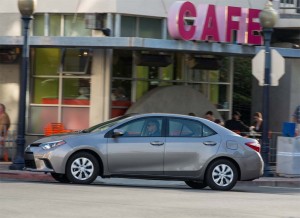
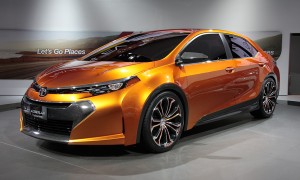
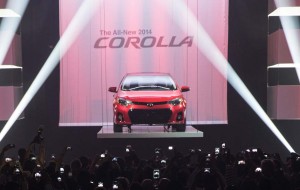
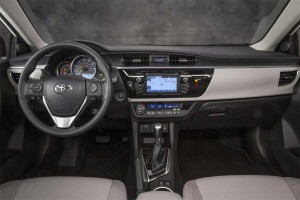
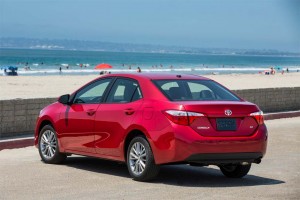
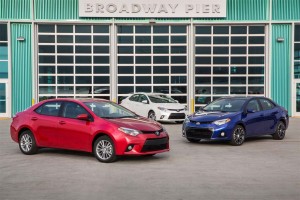
so how many people buy manuals?
For the Corolla to still use a 4-speed automatic is inexcusable on a 2014 car, even a base model.
Its very interesting that Toyota has done the opposite of what others have, re: styling in the US vs. styling in Europe. They don’t get the Lexus-like (or Ford Focus-like, take your choice) blackout facia, but a much more conservative look below the bumper. And considering making a hatchback too? Hmmmm.